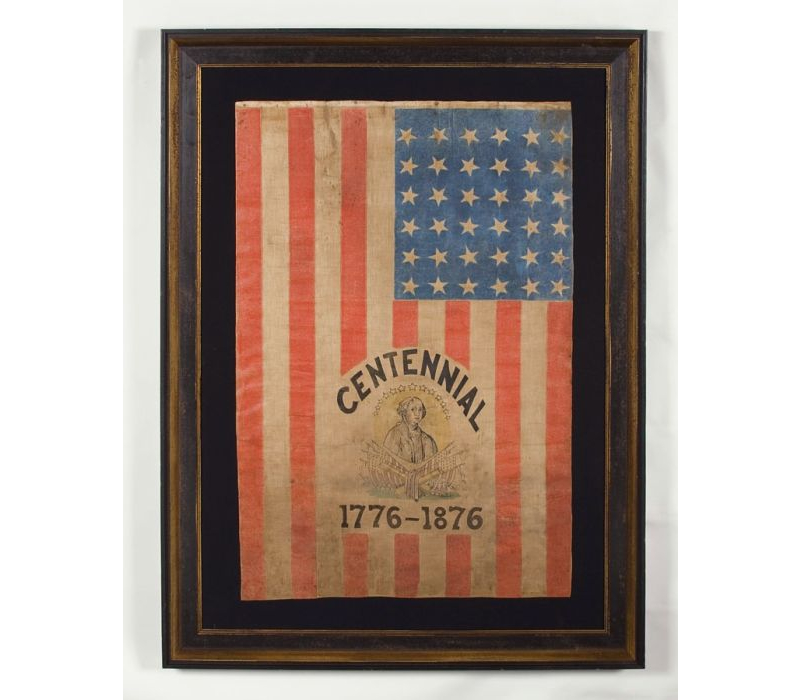
| |
36 STARS, GEORGE WASHINGTON PORTRAIT, MADE FOR THE 1876 CENTENNIAL EXPOSITION, ONE OF THE MOST PUBLISHED FLAG IN PRIVATE HANDS |
|
| Available: |
Sold |
| Frame Size (H x L): |
Approx. 52.5" x 37.75" |
| Flag Size (H x L): |
42.5" x 27.75" |
|
| Description....: |
|
36 STARS, GEORGE WASHINGTON PORTRAIT, MADE FOR THE 1876 CENTENNIAL EXPOSITION, ONE OF THE MOST PUBLISHED FLAG IN PRIVATE HANDS:
American parade flag, printed on coarse, glazed cotton. Set perpendicular to the stripes, so that the flag must be displayed vertically, is an open, tombstone-shaped window, within which is an elaborate four-color overprinted image and accompanying text. This includes a three-quarter portrait of George Washington, set on an oval, yellow ground, crowned by an arch of 13 stars in graduated sizes along the top. Below is an array of militaria, including crossed swords, muskets, and cannons, flanked at the bottom by sword hilts, cannon balls, a drum, and a bugle. In the arch above his head is the word "Centennial" and below are the dates "1776-1876".
This is only one of two parade flag known to exist in this exact design, though four companion flags are known with Lady Liberty in place of George Washington. The Lady Liberty examples come in two different sizes, each with a different illustration of our nation's foremost feminine icon. Two examples are known in the larger size and two in a size equivalent to the George Washington portrait flags. One of these latter examples has an overprint for the 1876 presidential campaign of Rutherford B. Hayes. And on another, penciled underneath than canton is the beginning of traced lettering that was intended to read "Hayes and Wheeler" (yet was never completed). For this reason it is logical to assume that these Washington and Lady Liberty flags were potentially ordered for the campaign rallies that were being held during this historic election year.
Hayes ran for the White House and won in 1876 in one of the most unusual elections in presidential history. He lost the popular vote but won in the electoral college under highly controversial circumstances. Flags from the Hayes campaign are extraordinarily rare and desired by the collectors of political flags.
Besides being one of only two known, and beyond being a large, graphic, and unusual example, this particular Washington portrait flag is very important for two reasons. One, it was a significant item in the collection of Boleslaw and Marie-Louise D'Otrange Mastai. The Mastia's were the first significant collectors of antique flags who actually did a book on the subject. Their 1973 text "The Stars & The Stripes" serves as a landmark in flag collecting. The flag is marked along the hoist, not only with the Mastai stamp (in red ink), but also with their inventory number (item 103). The Mastai's marked almost all of their flag-related objects in this fashion and while it's hard to argue that it can be considered defacement, the fact remains that it is an important mark to collectors because it records the flag's former presence among the items in the first and most widely recognized private collections of American in the world.
Two, of all of the Mastai flags, this is probably the most photographed and published. It appears in no less than three texts on flag collecting, including the two leading books. The citations follow:
* Mastai, B. & M.L.O. "The Stars & The Stripes" (1973, Knopf, New York), p. 169.
* Collins, Herbert Ridgeway. "Threads of History" (1987, Smithsonian Press), p. 207, item 439.
* Friz, Richard. "The Official Price Guide to World's Fair Memorabilia (1989, House of Collectibles), illustrated after p. 148 within an unnumbered, color insert section
The use of 36 stars on flags made for the 1876 Centennial International Exposition, when we actually had 37 states (until August 10th) or 38 states (afterward through 1889) was not uncommon. It was probably a matter of convenience, being easy to design with no further underlying purpose.
The cumulative aspects of this important flag and its great rarity make it one of the best printed flags that exist from our nation's 100-year anniversary, a time period when some of the most beautiful 19th century parade flags were made.
Mounting: Then flag has been hand-sewn to a 100% cotton background, black in color. The black fabric was washed to remove excess dye. An acid-free dye-setting agent was added to the wash to further set the dye and the fabric was heat-treated for the same purpose. The mount was then placed in a black-painted, hand-gilded and distressed Italian molding. The front is U.V. protective acrylic.
Condition: The flag was sent out for professional restoration due to staining, breakdown and losses in the stripes and the canton, as well as dye loss, all three of these things being most prominent at the fly end. Cleaning was pursued and an underlayment was adhered to the reverse of the flag, before color restoration was performed. The Mastai's had stored the flag improperly, which led to much of the associated damage. The great importance of the textile, however, warranted practically any condition and degree of conservation and it exists as one of them gems of the flag collecting hobby. |
|
|
|
| Collector Level: |
Flags for the truest Patriots. My best offerings |
|
| Flag Type: |
Parade flag |
|
| Star Count: |
36 |
|
| Earliest Date of Origin: |
1876 |
|
| Latest Date of Origin: |
1876 |
|
| State/Affiliation: |
Other |
|
| War Association: |
1866-1890 Indian Wars |
|
| Price: |
SOLD |
|
| |
Views: 4025 |
|
|
|

